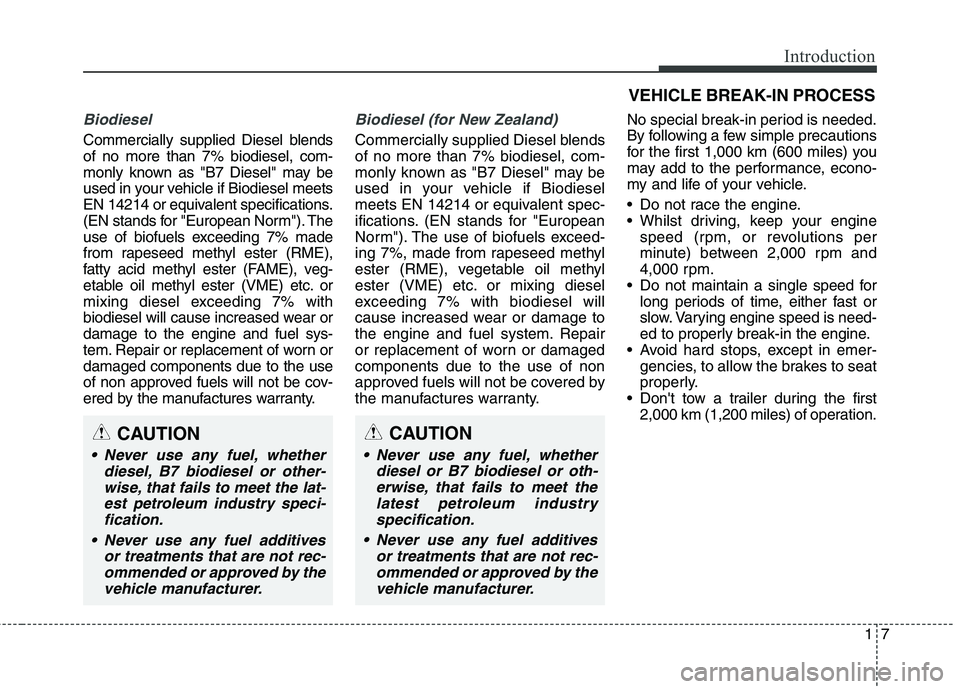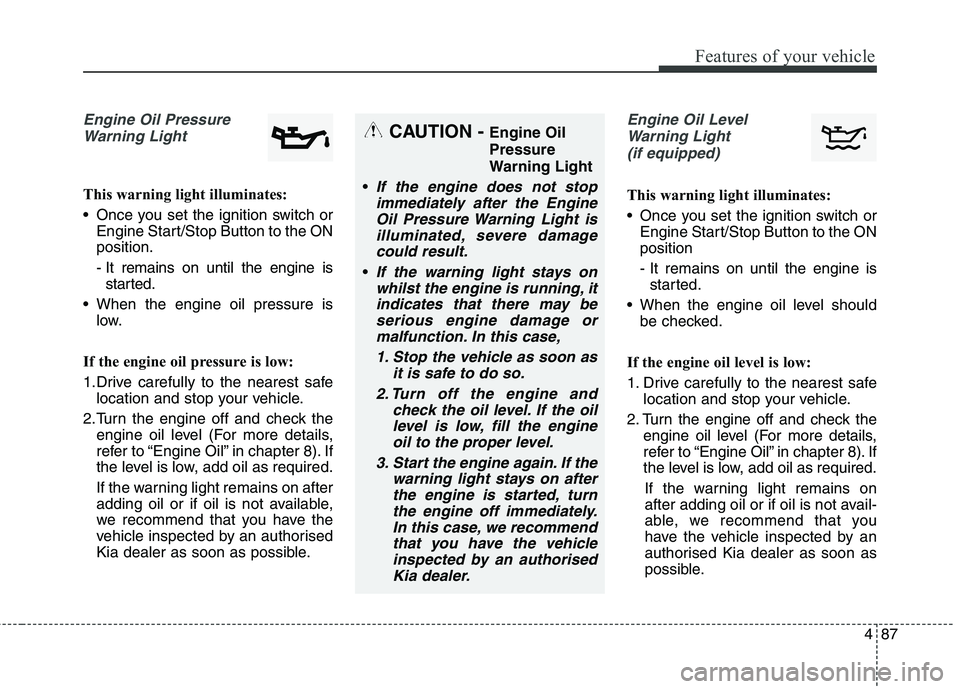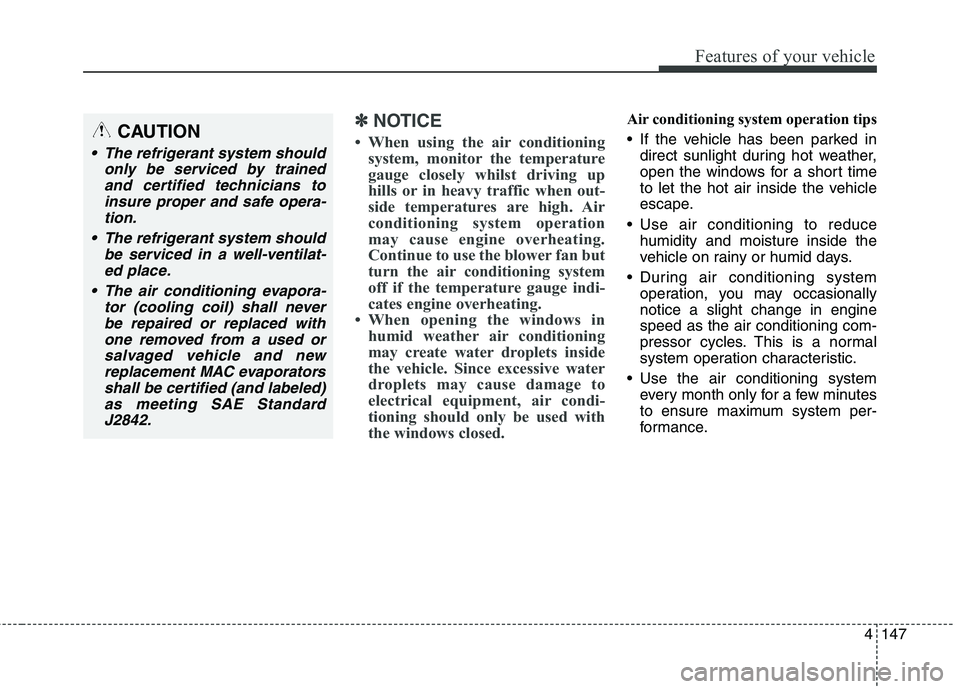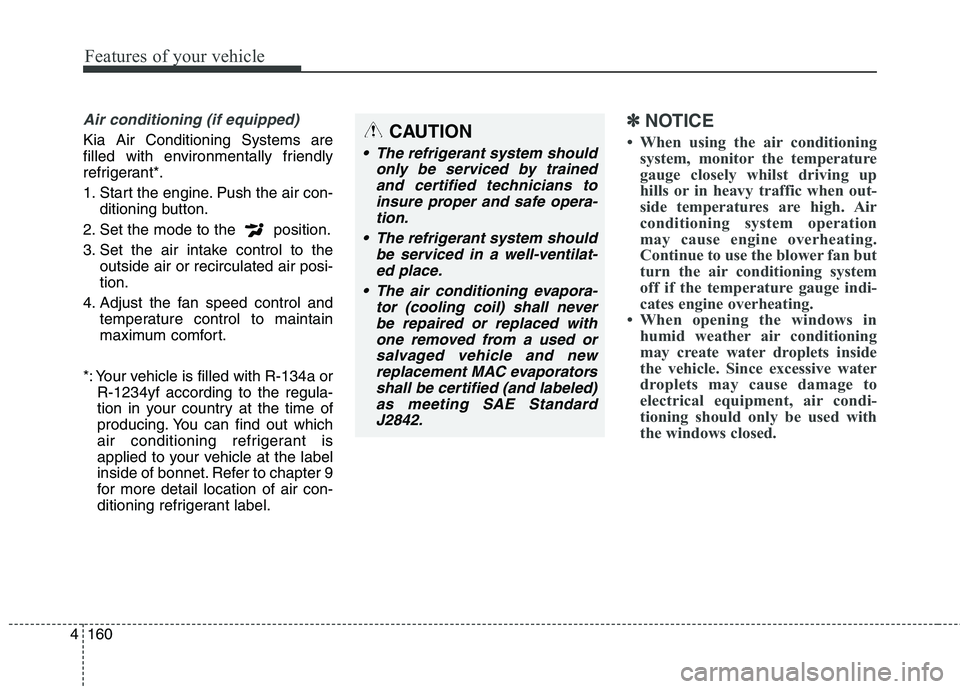2017 KIA CARENS RHD engine oil
[x] Cancel search: engine oilPage 9 of 723

Introduction
6
1
Operation in foreign countries
If you are going to drive your vehicle
in another country, be sure to:
Observe all regulations regarding
registration and insurance.
Determine that acceptable fuel is available. Diesel engineDiesel fuel
Diesel engine must be operated only
on commercially available diesel fuelthat complies with EN 590 or compa-
rable standard. (EN stands for
"European Norm"). Do not use
marine diesel fuel, heating oils, or
non-approved fuel additives, as this
will increase wear and cause dam-age to the engine and fuel system.
The use of non-approved fuels and /
or fuel additives will result in a limita-
tion of your warranty rights.
Diesel fuel of above cetane 51 is
used in your vehicle. If two types of
diesel fuel are available, use summer
or winter fuel properly according to
the following temperature conditions.
Above -5°C (23°F) ... Summer type
diesel fuel.
Below -5°C (23°F) ... Winter type diesel fuel.
Watch the fuel level in the tank very
carefully : If the engine stops through
fuel failure, the circuits must be com-
pletely purged to permit restarting.
CAUTION
Do not let any petrol or water enter the tank. This would makeit necessary to drain it out and to bleed the lines to avoid jam-ming the injection pump anddamaging the engine.
CAUTION - Diesel Fuel
(if equipped with DPF)
It is recommended to use the regulated automotive diesel fuelfor diesel vehicle equipped with the DPF system.
If you use diesel fuel includinghigh sulfur (more than 50 ppmsulfur) and unspecified addi-tives, it can cause the DPF sys- tem to be damaged and whitesmoke can be emitted.
Page 10 of 723

17
Introduction
Biodiesel
Commercially supplied Diesel blends of no more than 7% biodiesel, com-
monly known as "B7 Diesel" may be
used in your vehicle if Biodiesel meets
EN 14214 or equivalent specifications.
(EN stands for "European Norm"). The
use of biofuels exceeding 7% made
from rapeseed methyl ester (RME),
fatty acid methyl ester (FAME), veg-
etable oil methyl ester (VME) etc. or
mixing diesel exceeding 7% with
biodiesel will cause increased wear ordamage to the engine and fuel sys-
tem. Repair or replacement of worn ordamaged components due to the use
of non approved fuels will not be cov-
ered by the manufactures warranty.
Biodiesel (for New Zealand)
Commercially supplied Diesel blends of no more than 7% biodiesel, com-
monly known as "B7 Diesel" may be
used in your vehicle if Biodiesel
meets EN 14214 or equivalent spec-
ifications. (EN stands for "European
Norm"). The use of biofuels exceed-
ing 7%, made from rapeseed methyl
ester (RME), vegetable oil methyl
ester (VME) etc. or mixing diesel
exceeding 7% with biodiesel will
cause increased wear or damage to
the engine and fuel system. Repair
or replacement of worn or damagedcomponents due to the use of non
approved fuels will not be covered by
the manufactures warranty.No special break-in period is needed.
By following a few simple precautions
for the first 1,000 km (600 miles) you
may add to the performance, econo-
my and life of your vehicle.
Do not race the engine.
Whilst driving, keep your engine
speed (rpm, or revolutions per
minute) between 2,000 rpm and
4,000 rpm.
Do not maintain a single speed for long periods of time, either fast or
slow. Varying engine speed is need-
ed to properly break-in the engine.
Avoid hard stops, except in emer- gencies, to allow the brakes to seat
properly.
Don't tow a trailer during the first 2,000 km (1,200 miles) of operation.
CAUTION
Never use any fuel, whether
diesel, B7 biodiesel or other-wise, that fails to meet the lat-est petroleum industry speci-fication.
Never use any fuel additives or treatments that are not rec-ommended or approved by thevehicle manufacturer.
CAUTION
Never use any fuel, whether diesel or B7 biodiesel or oth-erwise, that fails to meet the latest petroleum industryspecification.
Never use any fuel additives or treatments that are not rec-ommended or approved by the vehicle manufacturer.
VEHICLE BREAK-IN PROCESS
Page 16 of 723

Your vehicle at a glance
6
2
ENGINE COMPARTMENT
ORP076001R
■■
Petrol engine 1.6L - GDI
❈ The actual engine room in the vehicle may differ from the illustration. 1. Engine oil filler cap ...........................8-33
2. Brake/clutch fluid reservoir ................8-38
3. Positive battery terminal ....................8-48
4. Negative battery terminal ..................8-48
5. Fuse box ............................................8-66
6. Air cleaner .........................................8-40
7. Radiator cap ......................................8-36
8. Engine coolant reservoir....................8-35
9. Engine oil dipstick..............................8-32
10. Windscreen washer fluid reservoir ..8-39
Page 17 of 723

27
Your vehicle at a glance
1. Engine oil filler cap ...........................8-33
2. Brake/clutch fluid reservoir ................8-38
3. Positive battery terminal ....................8-48
4. Negative battery terminal ..................8-48
5. Fuse box ............................................8-66
6. Air cleaner .........................................8-40
7. Radiator cap ......................................8-36
8. Engine coolant reservoir....................8-35
9. Engine oil dipstick..............................8-32
10. Windscreen washer fluid reservoir ..8-39ORP076002R/ORP076003R
■■Petrol engine 2.0L - MPI
❈ The actual engine room in the vehicle may differ from the illustration.
■■
Petrol engine 2.0L - GDI
Page 18 of 723

Your vehicle at a glance
8
2
1. Engine oil filler cap ...........................8-33
2. Brake/clutch fluid reservoir ................8-38
3. Positive battery terminal ....................8-48
4. Negative battery terminal ..................8-48
5. Fuse box ............................................8-66
6. Air cleaner .........................................8-40
7. Radiator cap ......................................8-36
8. Engine coolant reservoir....................8-35
9. Engine oil dipstick..............................8-32
10. Windscreen washer fluid reservoir ..8-39
11. Fuel filter..........................................8-40
ORP076083R
❈
The actual engine room in the vehicle may differ from the illustration.
■■
Diesel engine (U2-1.7L)
Page 183 of 723

487
Features of your vehicle
Engine Oil PressureWarning Light
This warning light illuminates:
Once you set the ignition switch or Engine Start/Stop Button to the ON position.
- It remains on until the engine isstarted.
When the engine oil pressure is low.
If the engine oil pressure is low:
1.Drive carefully to the nearest safe location and stop your vehicle.
2.Turn the engine off and check the engine oil level (For more details,
refer to “Engine Oil” in chapter 8). If
the level is low, add oil as required.
If the warning light remains on after
adding oil or if oil is not available,
we recommend that you have the
vehicle inspected by an authorised
Kia dealer as soon as possible.
Engine Oil Level
Warning Light (if equipped)
This warning light illuminates:
Once you set the ignition switch or Engine Start/Stop Button to the ON position
- It remains on until the engine isstarted.
When the engine oil level should be checked.
If the engine oil level is low:
1. Drive carefully to the nearest safe location and stop your vehicle.
2. Turn the engine off and check the engine oil level (For more details,
refer to “Engine Oil” in chapter 8). If
the level is low, add oil as required.
If the warning light remains on
after adding oil or if oil is not avail-
able, we recommend that you
have the vehicle inspected by an
authorised Kia dealer as soon as
possible.
CAUTION - Engine Oil Pressure
Warning Light
If the engine does not stop immediately after the Engine Oil Pressure Warning Light isilluminated, severe damagecould result.
If the warning light stays onwhilst the engine is running, it indicates that there may beserious engine damage ormalfunction. In this case,
1. Stop the vehicle as soon as it is safe to do so.
2. Turn off the engine and check the oil level. If the oillevel is low, fill the engine oil to the proper level.
3. Start the engine again. If the warning light stays on afterthe engine is started, turnthe engine off immediately. In this case, we recommendthat you have the vehicleinspected by an authorised Kia dealer.
Page 243 of 723

4147
Features of your vehicle
✽✽NOTICE
When using the air conditioning system, monitor the temperature
gauge closely whilst driving up
hills or in heavy traffic when out-
side temperatures are high. Air
conditioning system operation
may cause engine overheating.
Continue to use the blower fan but
turn the air conditioning system
off if the temperature gauge indi-
cates engine overheating.
When opening the windows in humid weather air conditioning
may create water droplets inside
the vehicle. Since excessive water
droplets may cause damage to
electrical equipment, air condi-
tioning should only be used with
the windows closed.Air conditioning system operation tips
If the vehicle has been parked indirect sunlight during hot weather,
open the windows for a short time
to let the hot air inside the vehicle
escape.
Use air conditioning to reduce humidity and moisture inside the
vehicle on rainy or humid days.
During air conditioning system operation, you may occasionallynotice a slight change in enginespeed as the air conditioning com-
pressor cycles. This is a normal
system operation characteristic.
Use the air conditioning system every month only for a few minutes
to ensure maximum system per-
formance.CAUTION
The refrigerant system should
only be serviced by trainedand certified technicians toinsure proper and safe opera-tion.
The refrigerant system should be serviced in a well-ventilat-ed place.
The air conditioning evapora- tor (cooling coil) shall neverbe repaired or replaced withone removed from a used or salvaged vehicle and newreplacement MAC evaporatorsshall be certified (and labeled) as meeting SAE StandardJ2842.
Page 256 of 723

Features of your vehicle
160
4
Air conditioning (if equipped)
Kia Air Conditioning Systems are
filled with environmentally friendly
refrigerant*.
1. Start the engine. Push the air con-
ditioning button.
2. Set the mode to the position.
3. Set the air intake control to the outside air or recirculated air posi- tion.
4. Adjust the fan speed control and temperature control to maintain
maximum comfort.
*: Your vehicle is filled with R-134a or R-1234yf according to the regula-
tion in your country at the time of
producing. You can find out which
air conditioning refrigerant is
applied to your vehicle at the label
inside of bonnet. Refer to chapter 9
for more detail location of air con-
ditioning refrigerant label.
✽✽ NOTICE
When using the air conditioning system, monitor the temperature
gauge closely whilst driving up
hills or in heavy traffic when out-
side temperatures are high. Air
conditioning system operation
may cause engine overheating.
Continue to use the blower fan but
turn the air conditioning system
off if the temperature gauge indi-
cates engine overheating.
When opening the windows in humid weather air conditioning
may create water droplets inside
the vehicle. Since excessive water
droplets may cause damage to
electrical equipment, air condi-
tioning should only be used with
the windows closed.CAUTION
The refrigerant system should
only be serviced by trainedand certified technicians toinsure proper and safe opera-tion.
The refrigerant system should be serviced in a well-ventilat-ed place.
The air conditioning evapora- tor (cooling coil) shall neverbe repaired or replaced withone removed from a used or salvaged vehicle and newreplacement MAC evaporatorsshall be certified (and labeled) as meeting SAE StandardJ2842.